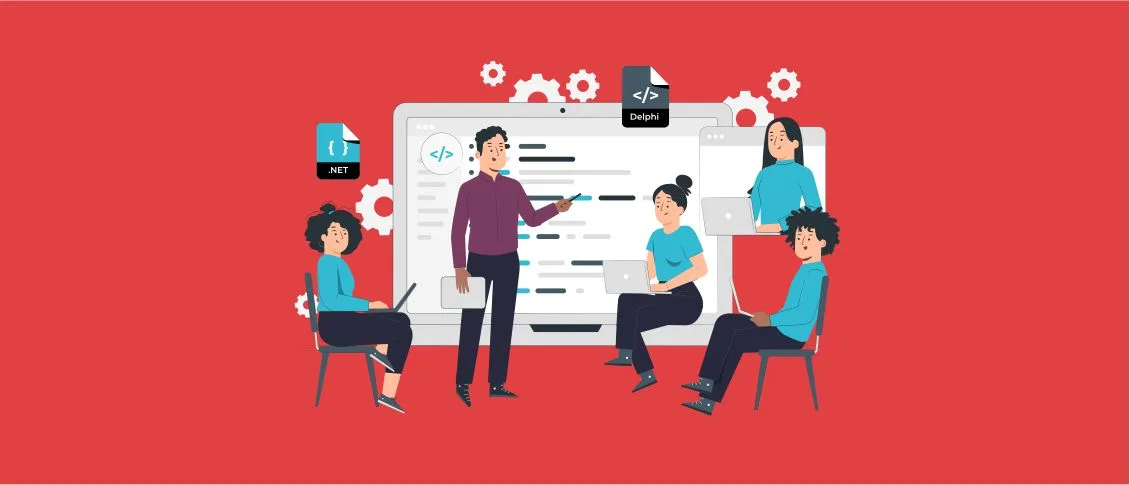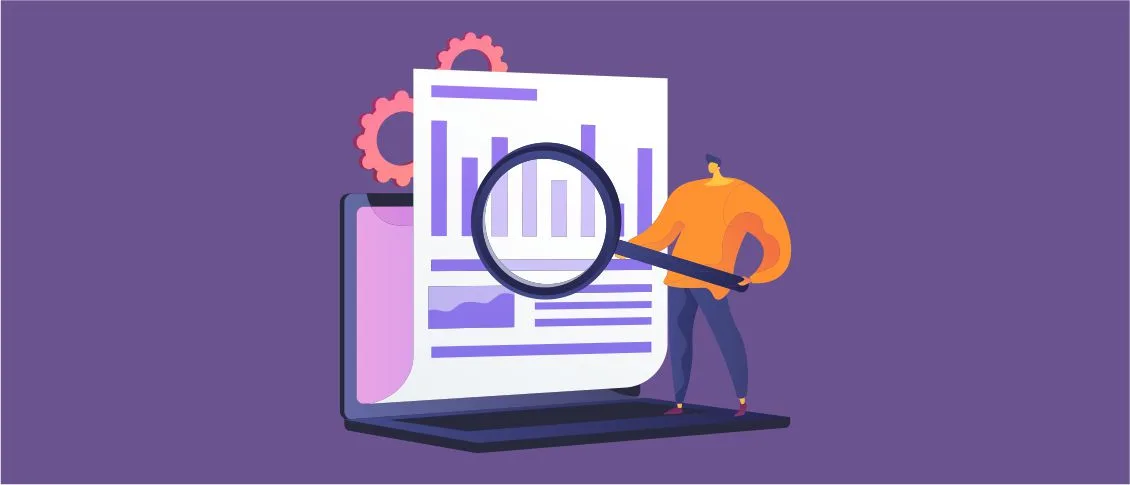- What Is Legacy System Integration?
- How to Integrate Legacy Systems with Modern Software: Main Approaches
- Point-to-Point (P2P) Integration
- Enterprise Service Bus (ESB)
- Application Programming Interface (API)
- Integration Platform as a Service (iPaaS)
- Robotic process automation (RPA)
- Steps for integrating legacy systems
- When Is Legacy System Integration Relevant?
- Legacy System Integration Benefits
- What are the key challenges of legacy system integration?
What Is Legacy System Integration?
Legacy system integration refers to the process of connecting and integrating older or “legacy” computer systems with newer systems, software, or technologies. Legacy systems are typically older computer systems, software applications, or databases that are still in use within an organization because they contain valuable data or perform critical functions.
Integration involves making these legacy systems compatible with newer technologies or systems to improve overall efficiency, functionality, and interoperability within an organization’s IT infrastructure. This could involve connecting legacy systems to newer software applications, updating interfaces to work with modern user interfaces, or migrating data from legacy databases to newer platforms.Legacy system integration is often necessary because organizations may have invested significant time and resources into developing and maintaining these older systems, and completely replacing them may be costly or impractical. By integrating legacy systems with newer technologies, organizations can leverage the benefits of both their legacy systems and newer solutions, enabling smoother business operations and better decision-making.
How to Integrate Legacy Systems with Modern Software: Main Approaches
Legacy system integration methods refer to the various techniques and approaches used to connect and integrate older or legacy systems with modern software applications or technologies. These methods aim to enable seamless communication, data exchange, and interoperability between legacy systems and newer systems or platforms.
Let’s look at some common methods for integrating legacy systems.
Point-to-Point (P2P) Integration
Point-to-Point (P2P) integration is a method used to establish direct connections between two systems or applications to enable data exchange and communication. In this approach, integration is typically implemented on a one-to-one basis, where each integration point connects one system to another without the use of intermediaries or centralized hubs.
Despite its limitations, Point-to-Point integration can be a viable solution for integrating systems with simple and well-defined interfaces, or for implementing temporary or ad-hoc integrations. However, as integration needs grow more complex or the number of integration points increases, organizations may need to consider adopting more scalable and centralized integration approaches, such as middleware-based integration or Service-Oriented Architecture (SOA).
Enterprise Service Bus (ESB)
Enterprise Service Bus (ESB) integration is an architectural approach and middleware technology used to facilitate communication, data exchange, and integration between disparate systems within an enterprise. ESB acts as a centralized hub or intermediary that connects various applications, services, and systems, enabling seamless interaction and interoperability.
Overall, ESB integration method offers a robust and flexible solution for implementing enterprise-wide integration initiatives, enabling organizations to achieve seamless connectivity, agility, and interoperability across their IT infrastructure.
Application Programming Interface (API)
Application Programming Interface (API) is a method of connecting different software systems or applications using their APIs to enable communication and data exchange. APIs define the interfaces and protocols that allow different software components to interact with each other.
Overall, API integration method provides a flexible and scalable approach to connecting disparate systems and applications, enabling organizations to leverage the functionality and data of different software components to build innovative solutions and streamline business processes.
Integration Platform as a Service (iPaaS)
Integration Platform as a Service (iPaaS) is a method of integrating various applications, systems, and data sources using cloud-based platforms and services. iPaaS solutions provide a centralized platform for designing, deploying, managing, and monitoring integration workflows and data flows.
Overall, iPaaS offers a comprehensive and scalable approach to integration, enabling organizations to streamline business processes, improve data visibility, and accelerate digital transformation initiatives. By leveraging cloud-based integration capabilities, iPaaS platforms empower organizations to adapt to changing business requirements and drive innovation in a rapidly evolving digital landscape.
Robotic process automation (RPA)
Robotic Process Automation (RPA) integration involves using software robots or “bots” to automate repetitive tasks, workflows, and processes across different applications and systems. RPA integrates with existing software applications through various methods to mimic human actions and interact with user interfaces.
By leveraging these integration methods, organizations can extend the capabilities of RPA and automate a wide range of business processes across heterogeneous IT environments, improving efficiency, accuracy, and scalability.
Steps for integrating legacy systems
Integrating legacy systems involves several steps to ensure a smooth and effective transition to modern software applications or platforms. Here’s a general outline of the steps involved in integrating legacy systems.
Assessment and planning:
- Evaluate existing legacy systems to understand their functionality, data structure, and dependencies.
- Identify specific integration requirements, including the need for real-time data sharing, user interface upgrades, or performance improvements.
- Develop a comprehensive integration plan with goals, timelines, resources, and potential challenges.
- Analyze and transform the required data.
Choose an approach to integration and realize it:
- Choose the most suitable integration approach based on the specific requirements and constraints of the legacy systems and modern software applications.
- Consider options such as API integration, middleware integration, legacy data integration, screen scraping, or legacy modernization based on factors such as complexity, cost, and impact on existing systems and processes.
Testing and Validation:
- Conduct thorough testing of the integrated solution to validate data consistency, functionality, performance, and security.
- Perform integration testing to verify the end-to-end functionality of data exchange and business processes across legacy and modern systems.
- Use testing frameworks, automated testing tools, and simulation environments to streamline the testing process and identify and address any issues or bottlenecks.
Deployment and Maintenance:
- Deploy the integrated solution into production environments following best practices for deployment, configuration, and monitoring.
- Establish maintenance procedures and support mechanisms to monitor the performance, stability, and security of the integrated systems.
- Continuously monitor and optimize the integration solution to address evolving business requirements, technology updates, and security vulnerabilities.
When Is Legacy System Integration Relevant?
Legacy system integration is relevant in a wide range of scenarios where organizations seek to modernize their IT infrastructure, optimize business processes, enhance customer experience, comply with regulations, facilitate mergers or acquisitions, or maximize ROI on existing IT investments. By integrating legacy systems with modern technologies, organizations can unlock new opportunities for innovation, growth, and competitiveness in today’s digital economy.
Legacy System Integration Benefits
Integrating legacy systems offers several benefits that can enhance organizational efficiency, productivity, and competitiveness. Here are some key advantages of legacy system integration:
- Improved Operational Efficiency:
- Legacy system integration streamlines business processes by automating repetitive tasks, reducing manual interventions, and eliminating data silos.
- Integration enables seamless data exchange and communication between disparate systems, enabling faster decision-making and response times.
- Enhanced Data Accessibility and Visibility:
- Integrating legacy systems with modern software applications or platforms centralizes data from various sources, providing a single source of truth for critical business information.
- Improved data accessibility and visibility enable organizations to make informed decisions based on real-time insights and analytics, leading to better business outcomes.
- Increased Employee Productivity:
- Legacy system integration automates routine tasks and workflows, freeing up employees to focus on higher-value activities that require human expertise and creativity.
- By reducing manual data entry and reconciliation efforts, integration improves employee productivity and satisfaction, leading to higher job performance and retention rates.
- Enhanced Customer Experience:
- Integration enables organizations to deliver seamless and personalized experiences to customers by accessing and leveraging customer data stored in legacy systems.
- By integrating legacy systems with customer-facing applications or CRM platforms, organizations can provide tailored products, services, and interactions that meet the unique needs and preferences of their customers.
- Cost Savings and ROI Maximization:
- Legacy system integration helps organizations maximize the return on investment (ROI) in their existing IT assets by extending their lifespan and functionality.
- By avoiding costly system replacements and leveraging existing infrastructure, integration reduces capital expenditures and operational costs while delivering tangible business value and competitive advantages.
- Agility and Innovation Enablement:
- Integration enables organizations to adapt quickly to changing business requirements, market dynamics, and technology trends by leveraging the flexibility and scalability of modern software applications and platforms.
- By integrating legacy systems with emerging technologies such as cloud computing, AI, and IoT, organizations can drive innovation, unlock new revenue streams, and gain a competitive edge in the marketplace.
- Compliance and Risk Mitigation:
- Legacy system integration helps organizations comply with industry regulations, standards, and data privacy laws by ensuring data accuracy, security, and auditability.
- By centralizing data management and implementing robust security controls, integration reduces compliance risks, minimizes data breaches, and protects sensitive information from unauthorized access or misuse.
In summary, legacy system integration offers a wide range of benefits that can transform business operations, drive revenue growth, and enhance customer satisfaction. By leveraging integration technologies and methodologies, organizations can modernize their IT infrastructure, optimize business processes, and unlock new opportunities for innovation and growth in today’s digital economy.
What are the key challenges of legacy system integration?
Legacy system integration presents several challenges that organizations must address to ensure successful implementation and operation. Here are some key challenges of legacy system integration:
Outdated Technology and Dependencies:
- Legacy systems may rely on outdated technology stacks, programming languages, or proprietary protocols that are no longer widely supported or compatible with modern software applications.
- Integration efforts may be hindered by dependencies on obsolete hardware, software libraries, or third-party components that are difficult to replace or update.
Data Inconsistencies and Quality Issues:
- Legacy systems often suffer from data inconsistencies, redundancies, and quality issues due to manual data entry, lack of data validation, and limited data governance practices.
- Integrating data from legacy systems with modern applications requires data cleansing, normalization, and reconciliation processes to ensure data accuracy, consistency, and integrity.
Limited Scalability and Performance:
- Legacy systems may lack the scalability and performance capabilities required to handle large volumes of data, transactions, or user interactions common in modern software applications.
- Integrating legacy systems with high-traffic or high-volume environments may result in performance bottlenecks, latency issues, or system crashes if not properly optimized and scaled.
Cost and Resource Constraints:
- Legacy system integration projects require significant investments in terms of time, resources, and budget to address technical challenges, mitigate risks, and achieve desired outcomes.
- Limited funding, expertise, or internal capabilities may pose constraints on integration efforts, leading to compromises in scope, quality, or timeline.
If you have already made the decision to migrate your system and are looking for a reliable partner, check out our migration services.










